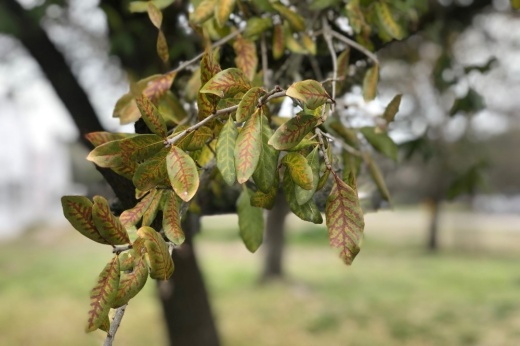In a nutshell
The infectious disease is caused by a fungus that invades and disables the water-conducting system in oak trees, according to Texas Oak Wilt.
Once infected with oak wilt, a tree will close up its xylem tubes that transfer water in an effort to cut off the spread of the fungus, said Jonathan Motsinger, the Department Head of Texas A&M Forest Service.
The tree’s leaves will then begin to wilt due to the lack of water, and the tree will eventually die, Motsinger said.
Zooming in
There are two ways for oak wilt to spread—an above ground and below ground method, Motsinger said.
The above ground method involves beetles landing on and picking up spores from the fungus of an infected oak tree and landing on oak trees with wounds that allow for the spread of the disease. The below ground method involves the propensity for oak trees to root graft, Motsinger said.
“The roots from one tree, when they come in contact with the roots from another tree, they will kind of fuse together where they cross,” Motsinger said. “The trees can actually share nutrients, share water from one to another, and it’s kind of a mutualistic survival mechanism. On the flip side, they can also share diseases.”
Motsinger said because of this a tree that is infected with oak wilt can spread it to other oak trees through their roots.
“Throughout Central Texas, we have a lot of live oak trees, which are very prone to developing these interconnected roots,” Motsinger said. “They’re close enough together where the disease can spread unchecked for potentially miles because there are just so many.”
The specifics
Red oaks, if infected with oak wilt, will die within a matter of weeks and cannot be saved. Live oaks, on the other hand, can show symptoms for several months before the tree succumbs, Motsinger said.
Oak wilt also primarily attacks healthy trees, Motsinger said.
“You could have a perfectly healthy tree that once it becomes infected, it will immediately start to decline,” he said.
One of the characteristics of a live oak tree infected with oak wilt is veinal necrosis on the tree’s leaves, which is a leaf pattern where the veins of the leaves turn brown while the rest of the leaf is still green. This is caused by the lack of water that is able to reach the leaves because of the disease, Motsinger said.
For red oaks and white oaks, symptoms include a thinner canopy because of lost leaves and may also include some veinal necrosis, Motsinger said.
What else?
If potential symptoms of oak wilt are noticed, Motsinger said he recommends hiring an arborist certified by the International Society of Arboriculture to run a diagnostic test.
Fees and costs associated with hiring a certified arborist are contingent on the company and area of the state, Mosinger said.
There are a couple of treatment options depending on the severity in the location of the infected trees, Motsinger said. Trees that have been recently infected with oak wilt can be injected with a fungicide, but this is only recommended for high-value trees that would have a significant impact if lost, he said.
On larger properties, it may not be feasible to do the fungicide injections due its larger scale and increased costs, Motsinger said.
Additionally, Motsinger said if the oak wilt infection has moved into the roots of the tree, it may require several injections over a number of years.
Trenching—a four-foot deep trench to sever interconnected roots—is another option for mitigating oak wilt, Motsinger said, and it is typically done on larger properties where an oak wilt “center” has been identified.
“One of the things that we look for in oak wilt isn't just a single tree, but a pattern of mortality, where over the course of a couple years, maybe an initial tree dies and then that fungus spreads,” Motsinger said. “Then you'll see more trees in the surrounding area die.”
The function of trenching severs the interconnected roots approximately 100 feet out from an infected tree, he said.
Also of note
Prevention of oak wilt is the most important factor in decreasing the spread of the disease, Motsinger said.
The best way to prevent oak wilt is to not prune trees anytime between February and the end of June, as that’s when the potential for the fungal mats to develop is highest, Motsinger said.
When pruning trees outside of that time frame or at any time when a tree is wounded, Motsinger said to spray the wound with paint immediately to seal it and prevent oak wilt infection.
“Anytime that an oak tree is wounded, we recommend painting that wound immediately,” he said.
Motsinger also said moving firewood can spread oak wilt. If an oak tree has died, is cut up into firewood and moved, the fungal mats and spores on it can spread the disease when moved to another location when a beetle lands on it and infects an adjacent tree at the new location.





